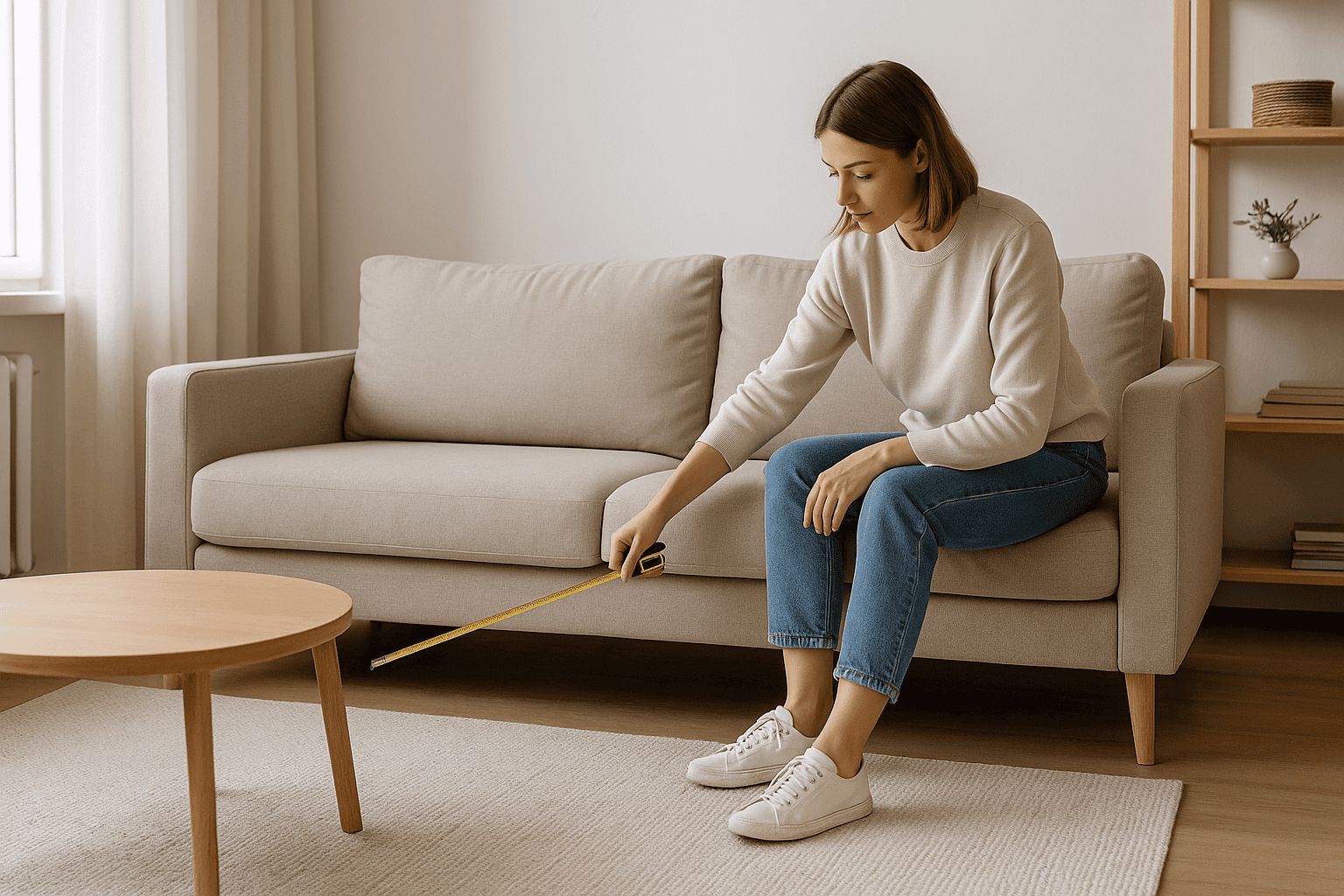If there is one thing that makes a small living room feel as if it grew overnight, it is a sofa chosen for real life rather than for the life we stage in our heads. Before you even pick up a tape measure, sit with a cup of tea and ask a few plain questions.
Who uses this room most days? Do people nap here? Is there a pet that claims the left cushion without fail? Do friends stop by for an hour or settle in for movie night? These small truths matter more than any trend or glossy photo. A sofa that serves your everyday habits will always feel right sized, because it is doing the job you hired it to do.
Sometimes this means letting go of an old picture. Maybe you grew up believing a living room needs a three seater, a loveseat, and a chair lined up like soldiers. In a small space that parade turns into a traffic jam.
One well chosen sofa that actually fits, plus a nimble side chair you can pull in, usually works harder than a full matching set. It sounds almost too practical, but this is where comfort starts.
If you like having a single reference point to check yourself, keep a quiet bookmark to a small living room sofa size guide. Glance at it when you are stuck, then return to noticing how you truly live.
Measure the room, then measure the path
The tape measure is your friend. Use it slowly, then use it again. Measure the length and width of the room wall to wall. Note doors that swing, baseboard heaters or radiators, built ins, and low windows that steal a few crucial centimeters. Jot down the ceiling height too, because low ceilings change the equation. If there is a bay window, write down the narrowest point. That pinch point decides what can pass.
Now measure the path your sofa has to take to reach the room. Get the height and width of the main door. Check the hallway width. Look for tight right angle turns. If there is an elevator, measure its depth. If there are stairs, measure the width between the banister and the opposite wall as well as the ceiling height over the tightest step.
The smallest measurement on this route is the hurdle your sofa must clear. Many deliveries fail not because a sofa is wrong for the room, but because it cannot make a corner on the way up.
People often fixate on width, yet depth and diagonal are the silent culprits. A compact 180 centimeter sofa can still be stubborn to move if the arms are high and the back is taller than expected. If you can, ask the store for a shipping diagram that lists overall height, width, depth, and the diagonal from the front bottom corner to the back top corner. That diagonal must be smaller than the clear diagonal of your tightest doorway or stair turn.
Read the room, not the catalog
Catalogs love to photograph sofas with acres of space around them. Your living room likely does the opposite. That is fine. Think in terms of proportion and sightlines rather than numbers alone. When you enter the room, what do you see first?
A window, a fireplace, a TV, a bookcase you love? If the sofa back rises above the window sill and blocks light, it will feel heavy even if it is technically small. If the arms intrude on a doorway line, people will subconsciously flinch every time they pass and the sofa will feel too big.
The goal is for the sofa to look like it grew there. In many small rooms that means a lower back, slimmer arms, and visible legs that lift the body of the sofa off the floor. When you can see the area rug running underneath, the whole composition breathes. The opposite can also be true.
A skirted base that kisses the floor can be charming and classic, but in a tight room it often reads as a block. There are exceptions, especially in cottage or traditional spaces, just fewer than we think.
The breathing space rule
Rooms work the way lungs do, with inhale and exhale. Your sofa needs a bit of air around it to inhale. Aim for a hand’s width between the sofa and the wall if it floats slightly, and only accept a true wall hug when the room is truly tiny.
Between the front edge of the sofa and the coffee table, keep a gap that lets knees pass without gymnastics. Around 40 to 45 centimeters is the sweet spot for most people. Closer, and your legs feel pinched. Farther, and you keep leaning forward awkwardly to set down a mug.
Walk paths matter too. If the sofa creates a corridor from the entry to the kitchen, try to hold that passage around 75 to 90 centimeters so two people can slip past each other without sidestepping. When space is extremely tight, a clear 60 centimeters can work for one person at a time, but you will feel it.
If TV viewing is part of the room’s job, give your eyes a comfortable distance. A quick rule of thumb is to sit roughly one and a half times the screen’s diagonal. It is not sacred. If you enjoy a closer, more cinema like feel, embrace it. Just make sure your neck and shoulders are not straining upward from a deep seat with a TV mounted too high.
Decoding sofa dimensions without the jargon headache
Sofas wear a lot of numbers. The ones that shape your daily comfort are simpler than the spec sheet suggests. Width is what most of us chase, but depth decides whether your feet dangle or your back slumps. Standard depths hover around 80 to 95 centimeters.
In small rooms, the sweet spot is often in the lower half of that range, because shallower seats let more floor show and make conversation easier. If you love to curl up, you can still choose a compact footprint with a chaise that extends on one side. You get the best of both worlds.
Seat height is the next big one. Many people feel comfortable between about 43 and 48 centimeters. Lower looks sleek but can make standing up feel like a squat, especially for taller guests or grandparents. Higher is kinder on knees and helps smaller rooms feel lively because you do not sink out of sight.
Arm style matters more than most of us admit. Wide rolled arms eat precious width. Slim track arms can give you back 10 centimeters of seating in the same overall span, and they read calm and clean.
Some designs skip arms altogether or keep them very low, which helps when the sofa must sit under a window sill. Back height plays a similar game. A lower back keeps lines open. A very tall back looks cozy, yet in a tight space it can dominate the scene like a headboard in the wrong room.
Legs are not just legs. A sofa on tapered wooden legs lets light travel underneath, which tricks the eye into reading more square footage. A block base that meets the floor can look grounded and elegant, but it draws a bold underline across your sightline when the room is already snug.
None of these are moral choices. They are simply tools you pick up or put down depending on your room’s story.
When a sectional is actually the right answer
Sectionals are not only for sprawling family rooms. A small, tightly proportioned two piece sectional can solve a tiny room that struggles with both seating and traffic. The key is discipline. Keep the returns short, the arms slim, and choose a chaise rather than a full L when you can. Three or four people will have a place to sit without interrupting the main walking route.
Where sectionals go sideways is when we fall for the sprawling versions. If the chaise blocks the only entry to the balcony or forces you to sidestep every time you carry in groceries, the room will nag at you all day. One practical trick is to tape the outline on the floor.
Use painter’s tape to mark the exact footprint, then live with it for a day. If you find yourself stepping on tape or bumping a hip, you just saved yourself a delivery fee and a headache.
Layouts that make a small room feel generous
There is no single correct placement, and that is part of the fun. In a narrow room, try floating the sofa a palm away from the long wall, then add a light side chair across from it. Keep the chair open under the seat so the floor line flows beneath. In a square room, centering the sofa on a window can be lovely if the back stays below the sill, with a petite round table to soften all the right angles.
Another move that works more often than people expect is the angled conversation. Place the sofa so it faces the focal point, then let a reading chair sit at a gentle angle rather than straight on. That small twist lets light bounce differently and creates a little moment for a floor lamp or a plant. Diagonal lines add energy to small spaces without costing centimeters.
Do not be afraid to let the sofa float. If you can leave 30 to 45 centimeters between the back of the sofa and a console table or wall, you create a slim lane where a lamp can shine and a basket can live. The room feels layered rather than cramped, and you gain a place to drop keys without marching to the far wall.
The quiet power of color and fabric
Size is not only about the tape measure. It is also about how the eye reads mass. In a small room, mid to light fabrics usually feel airier than very dark ones, especially if the walls are also light. A sofa close in tone to your wall color blends in so the outline recedes. Texture matters too. Nubby weaves or bouclé can look plumper. Linen and tight twill read slimmer even when the frame dimensions are identical.
Patterns can be allies. A small scale pattern like a subtle herringbone hides everyday wear and helps the sofa feel tailored. Large scale patterns demand attention, which can be gorgeous, but in a tight room they announce themselves loudly and make the sofa feel bigger. If you crave pattern, pillows are the safer place to play. You get personality without committing your largest piece.
Storage, sleepers, and other clever tricks
Multi use pieces are handy in small rooms, but they come with tradeoffs. A sleeper sofa is a lifesaver for guests. Remember that the mechanism adds weight and often steals a bit of seat softness. If the room is your primary lounging space, choose a sleeper with a simple foldout and test how the seat feels when it is closed.
Storage chaises are brilliant for extra blankets and board games. Make sure the lid opens fully without hitting the wall, and check that the chaise depth does not pinch your walkway.
An ottoman that doubles as a coffee table is a small space secret. With a tray on top it hosts drinks, and at movie time it turns into a chaise extension for whoever calls dibs. Watch the depth. A few centimeters make a difference when you are threading past with a bowl of popcorn.
Buying online without guessing
If you are shopping online, slow the process on purpose. Order fabric swatches and live with them for a few days. Put them on the floor and on a chair, and watch how they behave in morning light and at night. Some fabrics shift more than you would expect.
Read the dimensions closely and look for inner measurements if possible, because a sofa that is 180 centimeters wide with very thick arms might deliver only 130 centimeters of actual seating space.
Look at the return policy with clear eyes. Many brands allow returns within a set window but charge a restocking or pickup fee. That is not a deal breaker, but it belongs in your budget.
When in doubt, email customer service and ask for the diagonal measurement for delivery, the seat height, and the cushion fill details. The more you know, the more confident you will feel when the truck arrives.
Common pitfalls people rarely talk about
The most common mistake is buying for a future house that does not exist yet. If you live small now, buy for the home you have. Let the next home be a future gift to yourself. Another quiet mistake is seat depth. A deep sofa is alluring in photos, but if your feet hover above the floor and you need three pillows to sit upright, you will avoid the one piece meant to hold you.
Doorways are the sneaky saboteurs. Measure them. Make sure the sofa can angle in. Pay attention to radiator covers and wall sconces that steal a few centimeters in exactly the wrong spot. Arms that are too chunky come next on the list. Slim arms free up more real seating than people expect, and the sofa instantly looks lighter.
Rug size can trick the eye about sofa size too. A rug that is too small makes even a modest sofa look like a giant stomping on a postage stamp. Let the front legs of the sofa sit on the rug so the whole arrangement reads as one unit. The room calms down almost immediately.
A tiny case study you can borrow
Imagine a room roughly 3 by 4 meters, with one large window centered on the short wall and the entry door on a long wall near the corner. You want a place to read, watch some TV, and host two friends for an evening.
On paper that room begs for a modest sofa about 170 to 185 centimeters wide, with a depth near 85 centimeters and a seat height around 45 centimeters. Track arms or slim English arms keep the profile tidy. Legs that show give the floor line back to you.
Place the sofa facing the window so you are looking at light rather than toward a door. Keep a round coffee table about 80 centimeters across in front, with that friendly 40 to 45 centimeter gap for knees. A soft side chair slips to the right at a slight angle, just inside the doorway, leaving a clear 80 centimeter path from the entry to the far side of the room.
A low media console sits on the wall opposite the sofa, no taller than the sofa arm so the sightline stays open. The result is seating for four without elbow fights, a real walking path, and no blocked light.
Prefer a sectional? Take the same room and choose a two piece with a right side chaise that extends about 140 centimeters. Place it on the long wall, chaise toward the window, and nudge the coffee table a touch toward the sofa so the door path stays open. You gain stretch out comfort and still keep the room’s breath.
Quick, friendly formulas that help under pressure
If you are standing in a store and someone is pressing for a decision while your pulse ticks in your neck, hold a few simple ratios. Let the sofa be about two thirds the length of the wall it sits on. Aim for a coffee table roughly two thirds the sofa’s width. Keep the top of the coffee table close to the height of the sofa seat, give or take a few centimeters, so setting down a glass does not feel like a squat or a stretch.
For TV viewing, a distance around one and a half times the screen’s diagonal usually feels good, though your room can nudge that. For walkways, 75 to 90 centimeters makes passing easy, and 60 centimeters is the minimum most people tolerate for a short stretch. For seat height, many bodies like 43 to 48 centimeters. For compact room depth, 80 to 90 centimeters keeps your feet grounded without stealing the floor.
Translate those into your own language at home. Tape the outlines. Place a few cardboard boxes where the arms might be, and live with the pretend sofa for a day. There is something humbling about bumping into a box twice that makes you rethink a 95 centimeter deep arm you were certain you needed.
Make peace with the room you have
When a small living room makes you feel boxed in, it is tempting to overcorrect with a sofa that shouts. I understand. Quiet choices often travel farther. A sofa with honest proportions, slimmer arms, and a depth that lets your feet land puts people at ease. Conversation becomes easier.
You start reading in the corner without noticing that you chose to linger there. The room begins to hold you the way a good friend does, not with grandeur, but with steadiness.
There will be a moment on delivery day when you second guess everything. The sofa will look larger than you remembered because the room is empty and your nerves are loud. Give it a day.
Roll out the rug. Bring in the lamp. Let the coffee table find its distance. Add the blanket that somehow disappears every movie night. Step back. If you measured with care and chose with your real life in mind, the room will exhale and so will you.
That is the right size. Not the number in a catalog. Not the one your neighbor swears by. The one that makes your home feel more yours when you sit down, tuck your feet under you, and think, yes, this finally fits.


